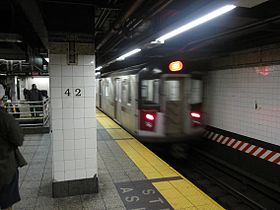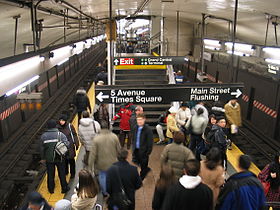Grand Central–42nd Street station
The Grand Central–42nd Street station (also signed as 42nd Street–Grand Central) is a major station complex of the New York City Subway. Located in Midtown Manhattan at 42nd Street between Madison and Lexington Avenues, it serves trains on the IRT Lexington Avenue Line, the IRT Flushing Line and the 42nd Street Shuttle. The complex is served by the 4, 6, and 7 trains at all times; the 5 and 42nd Street Shuttle (S) trains at all times except late nights; the <6> train during weekdays in the peak direction; and the <7> train during rush hours and early evenings in the peak direction.
This article is about the New York City Subway station. For the adjacent railroad terminal after which this station was named, see Grand Central Terminal. For the elevated rapid transit station that preceded the subway station complex, see Grand Central (IRT elevated station). For other uses, see 42nd Street.
Grand Central–42 Street
East 42nd Street and Park Avenue
New York, NY
![]() NYCT Bus: M1, M2, M3, M4, M42, M101, M102, M103, Q32, X27, X28, X37, X38, X63, X64, X68, SIM4C, SIM6, SIM8, SIM8X, SIM11, SIM22, SIM25, SIM26, SIM30, SIM31, SIM33C
NYCT Bus: M1, M2, M3, M4, M42, M101, M102, M103, Q32, X27, X28, X37, X38, X63, X64, X68, SIM4C, SIM6, SIM8, SIM8X, SIM11, SIM22, SIM25, SIM26, SIM30, SIM31, SIM33C![]() MTA Bus: BxM1, BxM3, BxM4, BxM6, BxM7, BxM8, BxM9, BxM10, BxM18, BM1, BM2, BM3, BM4, BM5, QM21, QM31, QM32, QM34, QM35, QM36, QM40, QM42, QM44
MTA Bus: BxM1, BxM3, BxM4, BxM6, BxM7, BxM8, BxM9, BxM10, BxM18, BM1, BM2, BM3, BM4, BM5, QM21, QM31, QM32, QM34, QM35, QM36, QM40, QM42, QM44![]() Academy Bus: SIM23, SIM24
Academy Bus: SIM23, SIM24![]() Metro-North Railroad: Harlem, Hudson, and New Haven Lines
Metro-North Railroad: Harlem, Hudson, and New Haven Lines
at Grand Central Terminal![]() Long Island Rail Road
Long Island Rail Road
at Grand Central Madison
Underground
3
June 22, 1915[2]
42nd Street–Grand Central
30,517,475[3] ![]() 33%
33%
2 out of 423[3]
The station is adjacent to Grand Central Terminal, which serves all Metro-North Railroad lines east of the Hudson River. There are multiple exits to Grand Central Terminal and to nearby buildings such as One Vanderbilt and the Chrysler Building. Numerous elevators make the station compliant with the Americans with Disabilities Act of 1990.
The present shuttle station was constructed for the Interborough Rapid Transit Company (IRT) as an express station on the city's first subway line, which was approved in 1900. The station opened on October 27, 1904, as one of the original 28 stations of the New York City Subway. As part of the Dual Contracts, the Flushing Line platform opened in 1915. After the Lexington Avenue Line platforms opened in 1918, the original station became the eastern terminal of the 42nd Street Shuttle, reconfigured with three tracks and two platforms. The Grand Central–42nd Street station complex has been reconstructed numerous times over the years, including in the early 21st century, when the shuttle station was reconfigured.
Grand Central–42nd Street is the second busiest station in the 423-station system, with 45,745,700 passengers in 2019; only the Times Square–42nd Street and 42nd Street–Port Authority Bus Terminal station complex has more riders.[4]
History[edit]
First subway[edit]
Planning for a subway line in New York City dates to 1864.[5]: 21 However, development of what would become the city's first subway line did not start until 1894, when the New York State Legislature passed the Rapid Transit Act.[5]: 139–140 The subway plans were drawn up by a team of engineers led by William Barclay Parsons, the Rapid Transit Commission's chief engineer. It called for a subway line from New York City Hall in lower Manhattan to the Upper West Side, where two branches would lead north into the Bronx.[6]: 3 A plan was formally adopted in 1897, which called for the subway to run under several streets in lower Manhattan before running under Fourth Avenue, 42nd Street, and Broadway. A previous proposal had called for the entire length of the subway to use Broadway, but the "awkward alignment...along Forty-Second Street", as the commission put it, was necessitated by objections to using the southernmost section of Broadway. All lawsuits concerning the route alignment were resolved near the end of 1899.[5]: 148 The Rapid Transit Construction Company, organized by John B. McDonald and funded by August Belmont Jr., signed the initial Contract 1 with the Rapid Transit Commission in February 1900,[7] in which it would construct the subway and maintain a 50-year operating lease from the opening of the line.[5]: 165 In 1901, the firm of Heins & LaFarge was hired to design the underground stations.[6]: 4 Belmont incorporated the Interborough Rapid Transit Company (IRT) in April 1902 to operate the subway.[5]: 182
The present shuttle station at Grand Central–42nd Street was constructed as part of the route segment underneath 42nd Street and Times Square, which extended from Park Avenue and 41st Street to Broadway and 47th Street. Construction on this section of the line began on February 25, 1901. Work for that section had been awarded to Degnon-McLean.[7] By late 1903, the subway was nearly complete, but the IRT Powerhouse and the system's electrical substations were still under construction, delaying the system's opening.[5]: 186 [8] The Grand Central–42nd Street station opened on October 27, 1904, as one of the original 28 stations of the New York City Subway from City Hall to 145th Street on the Broadway–Seventh Avenue Line.[9][5]: 186 The Grand Central shuttle platforms predate the terminal itself, as the construction of Grand Central Terminal was completed in 1913.[10]
Grand Central–42 Street
Grand Central–42 Street
IRT Third Avenue Line transfers[edit]
For over a decade, free transfers were provided between the subway station and 42nd Street on the elevated IRT Third Avenue Line. This started on June 14, 1942, the day after the IRT Second Avenue Line, which provided access to Queensboro Plaza and the IRT Flushing Line, was closed.[177] The Third Avenue Line closed on May 12, 1955, rendering the transfer obsolete.[178]







